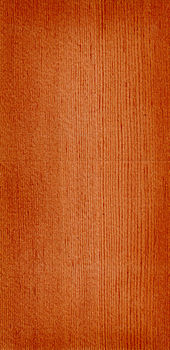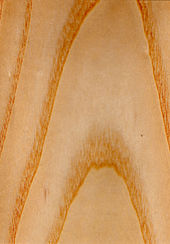Sorry, I did not specifically answer your question.
It is difficult to find wood in the first place and going in to the lumber yard with a rigid shopping list will result in frustration.
For a stripper the preferred wood you would like to end up with as visible on your boat might have close parallel growth rings. Like this.

The growth rings are made up of early wood (first growth in the spring) which is soft and light in color. And late wood (grown later in the season) which is dense and harder and darker in color.
If your strips look like this;

with an irregular grain or what is also called "figure" the growth rings are not parallel and the larger surfaces of light colored early wood present a problem. The problem is in sanding such wood the soft early wood will erode much quicker than the harder late wood and you will have a rippled surface instead of a flat fair surface.
These two examples are more like extremes of the wood you may find.
I'd suggest you look up "wood" on Wikipedia for more information. I have been looking at and handling wood for 50 years and I'm still learning. Knowing what to look for or what good wood looks like is worth many hours of study.
If you choose to use strips with a more interesting "figure" you must be aware of this early wood, late wood issue. You can reduce the potential for a rippled surface by using a hard or firm backing pad on your random orbital sander.
Some people suggest using a soft contour or interface pad to sand the exterior of their hull imagining the soft pad will conform to the convex surfaces. I would recommend against this. First the softness of the contour pad means with any pressure at all the soft foam is being compressed. This reduces force transferred to the sanding disk making any grit less effective. The natural response is to press harder which only compresses the soft pad further loading sanding force onto the leading edge of the rotation which digs into the wood and creates an unfair surface. This is what I call eraser sanding. Most people sand this way focusing force to an aggressive edge of the sanding disk to remove a rough spot.
To create a flat fair surface you must use a firm backing pad on you ROS with light pressure and a circular sanding motion to utilize the full surface of the sanding disk. This will cause the sanding disk to hit only the high spots aggressively and result in a fair surface. Yes, a hull has concave and convex curves and the firm backing pad used with the sander held flat and lightly will keep these areas fair also.
Messages In This Thread
- Strip: plain sawn board's
Marc Donnelly -- 6/2/2016, 8:05 am- Re: Strip: plain sawn board's
Etienne Muller -- 6/2/2016, 8:25 am- Re: Strip: plain sawn board's
Rob Macks/Laughing Loon CC&K -- 6/2/2016, 11:37 am- Re: Strip: plain sawn board's *PIC*
Rob Macks/Laughing Loon CC&K -- 6/2/2016, 1:42 pm- Re: Strip: plain sawn board's
Marc Donnelly -- 6/2/2016, 8:32 pm- Re: Strip: plain sawn board's
Bill Hamm -- 6/3/2016, 7:32 am- Re: Strip: plain sawn board's
Marc Upchurch -- 6/3/2016, 10:10 am- Re: Strip: plain sawn board's
Rod Tait -- 6/3/2016, 10:59 am- Re: Strip: plain sawn board's
Marc Donnelly -- 6/3/2016, 11:56 am- Re: Strip: plain sawn board's
Randy -- 6/3/2016, 12:39 pm
- Re: Strip: plain sawn board's
- Re: Strip: plain sawn board's
- Re: Strip: plain sawn board's
- Re: Strip: plain sawn board's
- Re: Strip: plain sawn board's



